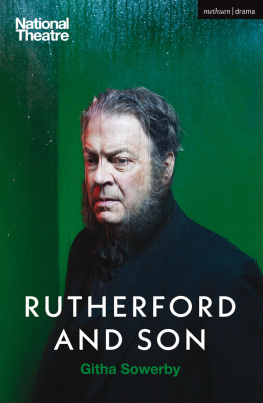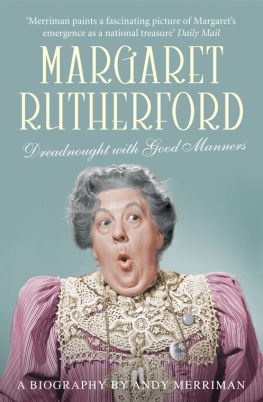Rutherford and Son
First staged in 1912 and described as the most powerful play produced in England in this decade, Githa Sowerbys powerful Edwardian classic on family and labour enjoyed huge success in London and New York before disappearing from view.
Set in the North Yorkshire home of the oppressive patriarch John Rutherford, Rutherford and Sons portrayal of the fathers obsession with his glass manufacturing business and his tyranny over the wrecked lives of his family is on a par with the dramas of Ibsen, Gorky and Granville Barker.
This edition of Rutherford and Son is published to coincide with the National Theatre production in May 2019.
Githa Sowerby
Little is known about Githa Sowerby other than that she spent her childhood in Tyne and Wear and her family were involved in the glass-making business. It seems she moved to London in her early twenties and probably wrote Rutherford and Son (1912) in her new southern location. Other plays followed: Before Breakfast (1912); A Man and Some Women (1914); Sheila (1917); The Stepmother (1924); The Policemans Whistle (1934). From then on she wrote numerous books for children with her elder sister Millicent. Githa Sowerby died in 1970.

METHUEN DRAMA
Bloomsbury Publishing Plc
50 Bedford Square, London, WC1B 3DP, UK
1385 Broadway, New York, NY 10018, USA
BLOOMSBURY, METHUEN DRAMA and the Methuen Drama logo are trademarks of Bloomsbury Publishing Plc
First published in Great Britain in 1912 by Sidgwick and Jackson
Published with additions from the 1912
prompt book by Methuen Drama 1994
This edition published 2019
Copyright Estate of Githa Sowerby, 1912, 1994, 2019
Introduction copyright Linda Fitzsimmons, 1991, 1994, 2019
Cover design: Ben Anslow
Photography (Roger Allam) David Stewart
Art direction and design National Theatre Graphic Design Studio
All rights reserved. No part of this publication may be reproduced or transmitted in any form or by any means, electronic or mechanical, including photocopying, recording, or any information storage or retrieval system, without prior permission in writing from the publishers.
Bloomsbury Publishing Plc does not have any control over, or responsibility for, any third-party websites referred to or in this book. All internet addresses given in this book were correct at the time of going to press. The author and publisher regret any inconvenience caused if addresses have changed or sites have ceased to exist, but can accept no responsibility for any such changes.
No rights in incidental music or songs contained in the work are hereby granted and performance rights for any performance/presentation whatsoever must be obtained from the respective copyright owners.
All rights whatsoever in this play are strictly reserved and application for performance etc. should be made before rehearsals by professionals and by amateurs to Samuel French at 2432 Stephenson Way, London, NW1 2HD, UK, Email: . No performance may be given unless a licence has been obtained.
A catalogue record for this book is available from the British Library.
A catalog record for this book is available from the Library of Congress.
ISBN: PB: 978-1-350-13277-1
ePDF: 978-1-350-13278-8
eBook: 978-1-350-13279-5
Series: Modern Plays
To find out more about our authors and books visit www.bloomsbury.com and sign up for our newsletters.
Rutherford and Son
Rutherford and Son was first performed at the Court Theatre, London, on 31 January 1912, with the following cast:
| Ann | Agnes Thomas |
| Mary | Thyrza Norman |
| Janet | Edyth Olive |
| John | Edmund Breon |
| Richard | Frank Randell |
| John Rutherford | Norman McKinnel |
| Martin | A. S. Homewood |
| Mrs Henderson | Agnes Hill |
Produced by John Leigh
This new edition of Rutherford and Son was published to coincide with the National Theatres 2019 revival at the Lyttelton Theatre on 16 May 2019, with the following cast and creative team:
| John Rutherford | Roger Allam |
| Martin | Joe Armstrong |
| Richard | Harry Hepple |
| Ann | Barbara Marten |
| Janet | Justine Mitchell |
| Mrs Henderson | Sally Rogers |
| John | Sam Troughton |
| Mary | Anjana Vasan |
| Singers | Sarah Dacey, Roshi Nasehi and Osnat Schmool |
| Director | Polly Findlay |
| Set and Costume Designer | Lizzie Clachan |
| Lighting Designer | Charles Balfour |
| Movement Director | Polly Bennett |
| Sound Designer | Paul Arditti |
| Music | Kerry Andrew |
| Assistant Composer and Music Director | Sarah Dacey |
| Company Voice Work | Simon Money |
| Dialect Coach | Danile Lydon |
| Staff Director | Hannah Joss |
| Project Producer | Rachel Quinney |
| Production Manager | Anthony Newton |
| Stage Manager | Sarah Alford-Smith |
| Deputy Stage Manager | Anna Hill |
| Assistant Stage Managers | Louise Quarterman and Lizzie Cooper |
| Casting | Jacob Sparrow and Sam Stevenson |
| Costumer Supervisor | Johanna Coe |
| Wigs, Hair and Make-up Supervisor | Adele Brandman |
| Prop Supervisor | Chris Lake |
| Publicist | Mary Parker |
Scene: living room in John Rutherfords house.
Two days elapse between Acts One and Two. One night between Acts Two and Three.
John Rutherfords house stands on the edge of the moor, far enough from the village to serve its dignity and near enough to admit of the master going to and from the Works in a few minutes a process known to the household as going across. The living room, in which the family life has centred for generations, is a big square room furnished in solid mahogany and papered in red, as if to mitigate the bleakness of a climate that includes five months of winter in every year. There is a big table in the middle of the room covered with a brown cloth at which the family take their meals. An air of orderliness pervades the room, which perhaps accounts for its being extremely uncomfortable. From above the heavy polished sideboard the lateJohn Rutherfordlooks down from his frame and sees the settle and armchair on either side of the fire, the marble clock on the mantelpiece, the desk with its brass inkstand and neatly arranged bundles of papers precisely as he saw them in life














